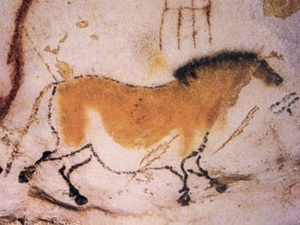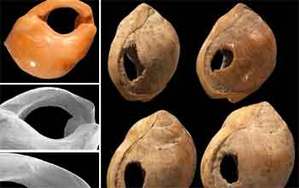Ancient Behavior

Your humble reporter has had a longstanding interest in human evolution. Not just in terms of understanding where we came from, but also where we may be going. There is also the fascinating question of re-capitulation: do children in a few years go through the same kinds of developmental phases that our ancestors went through over thousands of years?
One of the Big Questions has been “When did early humans begin to think and behave in some of the same ways that we do?”
This is often called “behavioral modernity” and one of its measures is in the appearance of objects used purely as decoration or ornamentation: items that are widely regarded as having symbolic rather than practical value. Their visual and symbolic impact are greatly increased if they are displayed on the body as necklaces, pendants, earrings or bracelets or attached to clothing. The appearance of ornaments like these may well be linked to a growing sense of self-awareness and identity amongst humans. Presumably any symbolic meanings would have been shared by members of the same group.
Amongst the oldest known symbolic ornaments in Europe are perforated animal teeth and shell beads that have been dated to the Upper Paleolithic era, that is no more than 40,000 years ago. These finds are associated with both modern human and late Neanderthal sites. Together with cave paintings and engravings they offer the strongest indications that European societies of those times were capable of abstract thinking. They began to be able to symbolize their ideas without relying on obvious links between a meaning and a sign. But there is now a growing body of evidence to indicate that symbolic cultures consisting of engravings, personal ornaments and systematic use of beads had emerged much earlier in Africa.
In a recently published paper in the Proceedings of the National Academy of Sciences archaeologists from Morocco, the United Kingdom, France and Germany, have shown that some of the earliest examples of bead making may date back as far as 82,000 years ago in North Africa.
The evidence is in the form of deliberately perforated Nassarius marine shells, some still smeared with red ochre, that were found deep down in the Grotte des Pigeons at Taforalt in northeastern Morocco. A multidisciplinary team has been working in this massive limestone cave for the past five years. The finds come from a sequence of ashy deposits that have been independently dated by scientists at Oxford and in Australia using four different techniques that allow them to make accurate age estimates for the layers containing the shells.

The shell beads have been studied by experts in France who have confirmed that they are a shallow marine species gathered from the beach, which even in the past lay more than 30 miles from the cave. Once collected, the dead shells were then probably perforated, painted with ochre and used as personal ornaments. Some of the beads show microscopic wear patterns that would suggest they were suspended from a necklace or bracelet. The application of red pigment may have been intended to give them added visual symbolic value. There’s not much doubt that this was part of a very deliberate cultural practice.
This finding suggests that forty thousand years earlier than anyone knew, there were people on this planet who could think in symbols, and engaged in rituals that were meaningful for them.
Time to re-write those history books again!
“Why is it so painful to watch a person sink? Because there is something unnatural in it, for nature demands personal progress, evolution, and every backward step means wasted energy.”
–August J. Strindberg (Swedish Dramatist, Novelist and Poet, 1849-1912)
“What we usually call human evolution is the awakening of the Divine Nature within us.”
–“Peace Pilgrim” (a.k.a. Mildred Norman, American Peace Activist, 1908-1981)







Richard:”Glut”by_Alex_Wright.>Read!